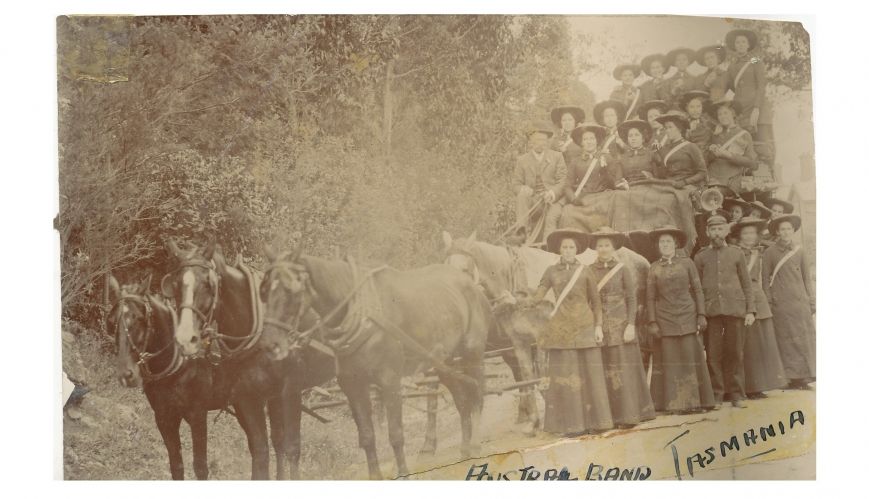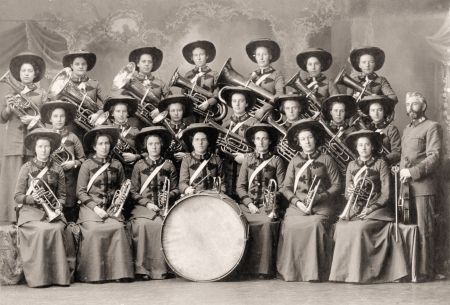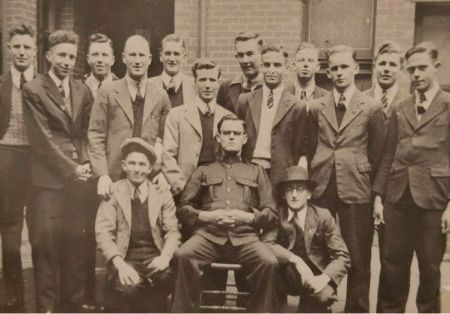The Quirky Army

The Quirky Army
The Austral Lasses Band on tour in Tasmania in the early 1900s.
When the lasses banded together
Ruby Strange, later Major Ruby, was a member of The Salvation Army ‘Austral Lasses Band’ at the turn of the 20th century and recorded many of the band’s experiences.
The Austral Lassies Band was a brass band that she says “drew great crowds because it was unique in being all lassies”. (Whether the band’s popularity was due to its musical proficiency or the comeliness of its members is unknown.)
The band toured “the Commonwealth and New Zealand” and so successful was its odyssey that it was renamed ‘The Famous Austral Lassies Band’ for its second tour, according to Ruby.
 The Austral Lasses Band in 1906.
The Austral Lasses Band in 1906.
Commencing at Yea, Victoria, on 20 August 1905, the girls performed non-stop for two years, “covering something like 16,000 miles by rail, boat, horse-drawn coaches and on foot” with “many and varied experiences during that wonderful tour” including two earthquakes, being [sand]bar bound on the south coast of New Zealand for two days and being asked, “to play at the great Band Contest held in the Exhibition Building at Christchurch”.
How’d the girls go? “The adjudicators classed our band as an A1 Organ Band; we were very thrilled,” wrote Ruby.
It was a long way from their humble beginnings when they’d practice from 9am to 6pm under Major Will Gore in “the old Hamodava Tea Room upstairs the back of Headquarters, Bourke Street” in Melbourne. “At first came some weird sounds,” Ruby writes. But the players from NSW, Victoria, Tasmania, Queensland and New Zealand persevered for six weeks and “Will Gore soon brought about perfection”.
Ruby writes that many of the lassies “became officers when the band disbanded”, and, most importantly, “many souls were won for Christ during that great tour”.
Rabbits, cauliflowers and a conversion
Some 101 years ago, in 1921, the Army’s War Cry reported that a labourer wandered into an English country corps’ Sunday meeting and plonked himself down in the back pew.
Worshippers were surprised by the bloke’s companions from the animal and vegetable kingdoms – under his arms, he was carting around two rabbits and several cauliflowers.
As the officer made a public appeal for prayer, the man, visibly crying, made his way to the mercy seat, accompanied by his unusual entourage. After the meeting, newly converted, the unnamed chap asked the captain to “go to the squire’s house with me. I trapped these two rabbits on his land and stole these cauliflowers from his garden”.
Together they called on the squire who, after hearing the man’s confession and the story of his conversion, gave him the rabbits and cauliflowers and handed the captain a pound note for the corps fund.
Girls on that side and boys on the other
At one time, Salvation Army officers could only marry Salvation Army officers, officer cadets had to ensure they had permission from training college staff to seek out a possible romantic relationship with another cadet or an officer, and people applying to be candidates for officership were sometimes grilled on their dating history and likely dating decisions.

Those scenarios may seem weird or even cult-like to young people and contemporary Salvos, and intrusively controlling in the light of now-existing understandings of privacy and inter-personal notions of dignity and respect, but in earlier times, the Army was big on avoiding the appearance of evil – perception, and PR – as well as trying to help people avoid any actual real wrongdoings or hurt feelings.
This even extended to Salvation Army architecture, with the ‘old Training College’ in the Melbourne CBD (pre-Royal Parade in Carlton) having a men’s staircase and a women’s staircase.
In this photo, male cadets of the Hold Fast session are photographed in the ‘Women’s Side Quadrangle’. The men, we are told, were not ‘wife hunting’, and Commissioner Sumsion (seated) “agreed to be photographed with the group”, according to a report.